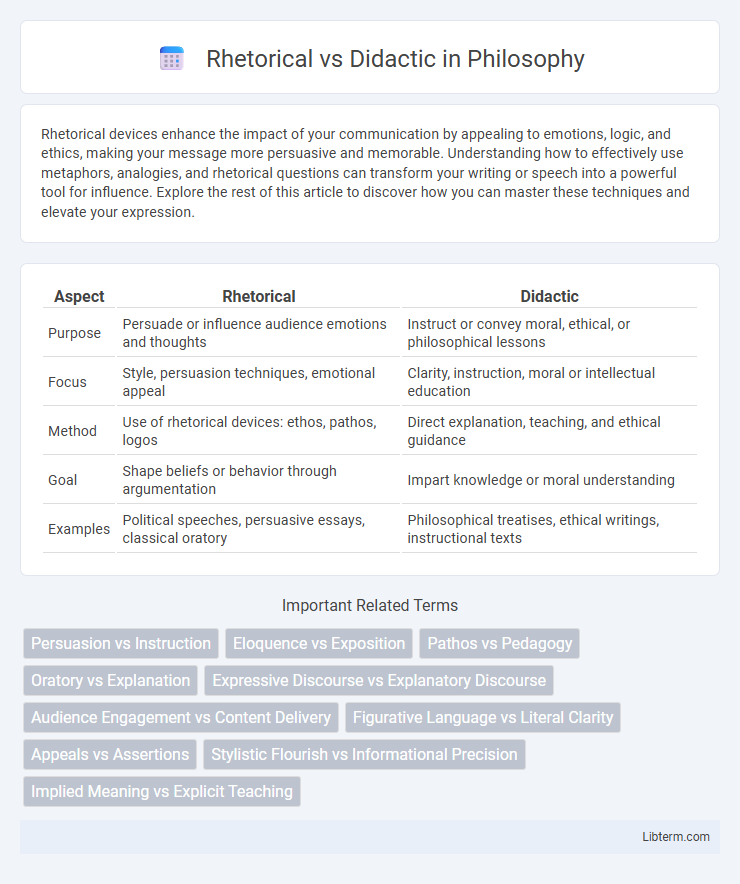Rhetorical devices enhance the impact of your communication by appealing to emotions, logic, and ethics, making your message more persuasive and memorable. Understanding how to effectively use metaphors, analogies, and rhetorical questions can transform your writing or speech into a powerful tool for influence. Explore the rest of this article to discover how you can master these techniques and elevate your expression.
Table of Comparison
| Aspect | Rhetorical | Didactic |
|---|---|---|
| Purpose | Persuade or influence audience emotions and thoughts | Instruct or convey moral, ethical, or philosophical lessons |
| Focus | Style, persuasion techniques, emotional appeal | Clarity, instruction, moral or intellectual education |
| Method | Use of rhetorical devices: ethos, pathos, logos | Direct explanation, teaching, and ethical guidance |
| Goal | Shape beliefs or behavior through argumentation | Impart knowledge or moral understanding |
| Examples | Political speeches, persuasive essays, classical oratory | Philosophical treatises, ethical writings, instructional texts |
Understanding Rhetorical and Didactic Approaches
Rhetorical approaches emphasize persuasion through ethos, pathos, and logos, aiming to influence audience beliefs or emotions via stylistic and strategic language use. Didactic methods prioritize instructive content, focusing on clear, direct communication of knowledge or moral lessons to facilitate understanding and learning. Mastery of both approaches enhances communication effectiveness by balancing engagement with informative clarity in diverse contexts.
Defining Rhetorical Techniques
Rhetorical techniques encompass devices such as ethos, pathos, and logos that enhance persuasion by appealing to credibility, emotion, and logic respectively. These strategies aim to influence an audience's perception and response through skillful language and stylistic elements like metaphor, repetition, and rhetorical questions. Unlike didactic methods that prioritize clear instruction and moral lessons, rhetorical techniques focus on engaging and motivating audiences through nuanced communication.
Core Features of Didactic Methods
Didactic methods emphasize systematic instruction designed to convey clear, structured knowledge, focusing on explanation, demonstration, and practice. Core features include a teacher-centered approach, step-by-step guidance, and measurable learning outcomes aimed at skill acquisition and comprehension. This method prioritizes factual information and logical sequencing to ensure effective knowledge transmission and learner understanding.
Historical Perspectives: Rhetoric vs Didacticism
Rhetoric, rooted in ancient Greek and Roman traditions, emphasized persuasive communication and public discourse, shaping political and legal practices throughout history. Didacticism, originating from classical educational philosophies, prioritized instruction and moral teaching, often manifesting in literature and religious texts designed to convey ethical lessons. The historical interplay between rhetoric and didacticism reflects evolving cultural values on persuasion versus instruction in shaping knowledge and behavior.
Purposes and Objectives: Persuasion vs Instruction
Rhetorical communication primarily serves the purpose of persuasion by appealing to emotions, ethics, and logic to influence an audience's beliefs or actions. Didactic communication focuses on instruction, aiming to educate or provide clear, structured information to enhance understanding and learning. While rhetoric seeks to motivate change, didacticism emphasizes clarity and knowledge retention through factual presentation.
Audience Engagement in Rhetorical and Didactic Styles
Rhetorical style captivates audience engagement through persuasive techniques such as emotional appeals, vivid imagery, and rhetorical questions that provoke thought and invite participation. Didactic style focuses on clear, structured communication aimed at instructing or informing, often relying on logical explanations and direct advice to maintain audience attention. Effective audience engagement in rhetoric involves stimulating curiosity and emotional connection, whereas didactic engagement depends on clarity, relevance, and practical application of information.
Common Examples in Literature and Media
Rhetorical works, such as Martin Luther King Jr.'s "I Have a Dream" speech and Shakespeare's "Julius Caesar," use persuasive language and stylistic devices to influence audiences emotionally and intellectually. Didactic literature, exemplified by Aesop's Fables and George Orwell's "Animal Farm," aims to teach moral lessons or practical concepts through clear, instructive narratives. In media, rhetorical techniques appear in political debates and advertising, while didactic approaches are prevalent in educational documentaries and self-help books.
Advantages and Limitations of Each Approach
Rhetorical approaches excel in engaging audiences through persuasive language and emotional appeal, enhancing memorability and impact but may sacrifice clarity and straightforwardness. Didactic methods prioritize clear, structured instruction promoting comprehension and retention, yet can risk appearing rigid or overly simplistic, potentially reducing engagement. Balancing these approaches maximizes both persuasive power and educational effectiveness in communication.
Blending Rhetorical and Didactic Strategies
Blending rhetorical and didactic strategies enhances communication by combining persuasive techniques with instructive clarity, ensuring the message is both impactful and educational. This integration leverages rhetorical appeals such as ethos, pathos, and logos alongside didactic elements that promote understanding and retention of information. Effective use of this blend leads to audience engagement while facilitating learning outcomes across diverse contexts.
Practical Applications in Modern Communication
Rhetorical techniques enhance persuasive communication by appealing to emotions, ethos, and logic, making them essential in marketing, politics, and public speaking for influencing audience behavior. Didactic communication prioritizes clear, instructive messaging useful in educational content, corporate training, and technical documentation to ensure knowledge transfer and skill development. Understanding when to apply rhetorical flair versus didactic clarity improves message effectiveness across diverse modern communication platforms.
Rhetorical Infographic

 libterm.com
libterm.com